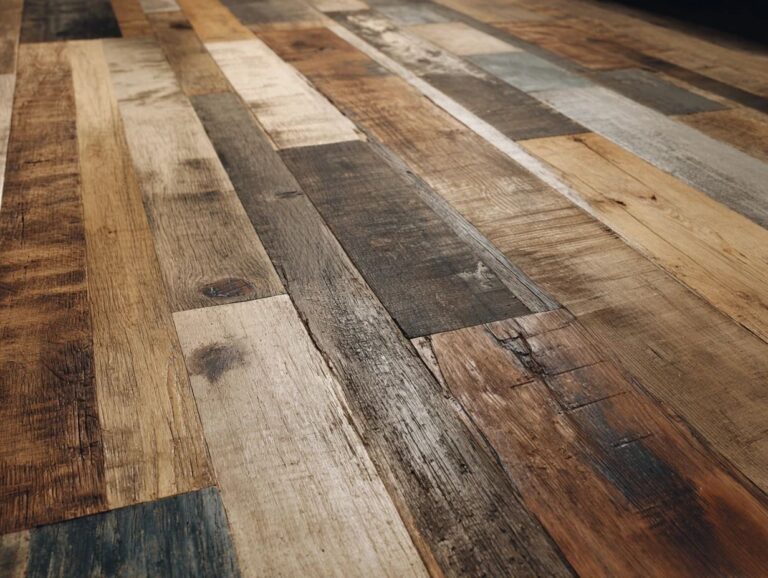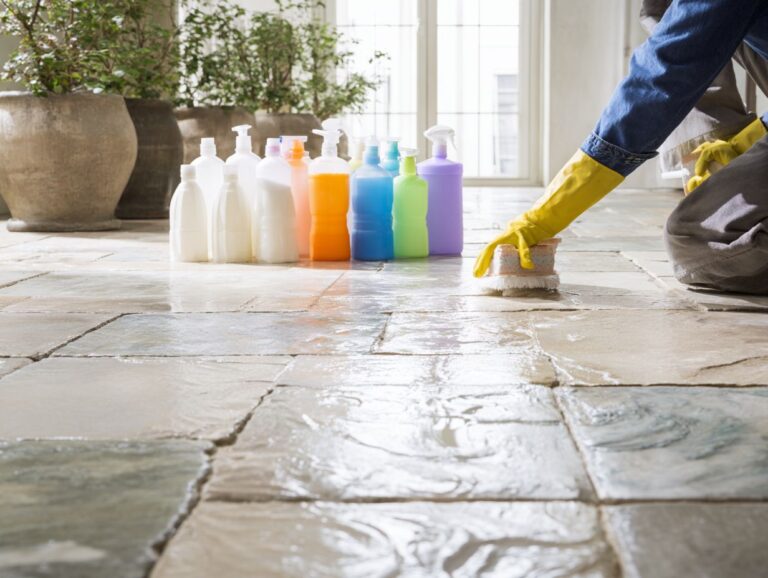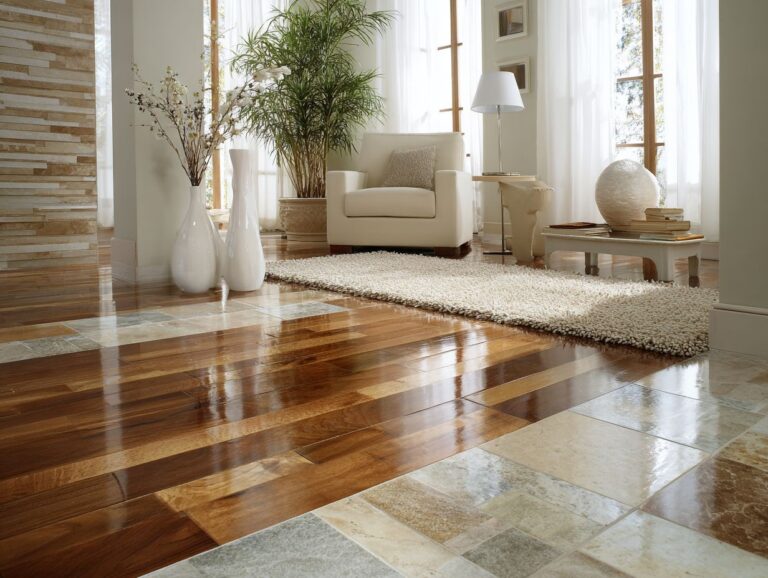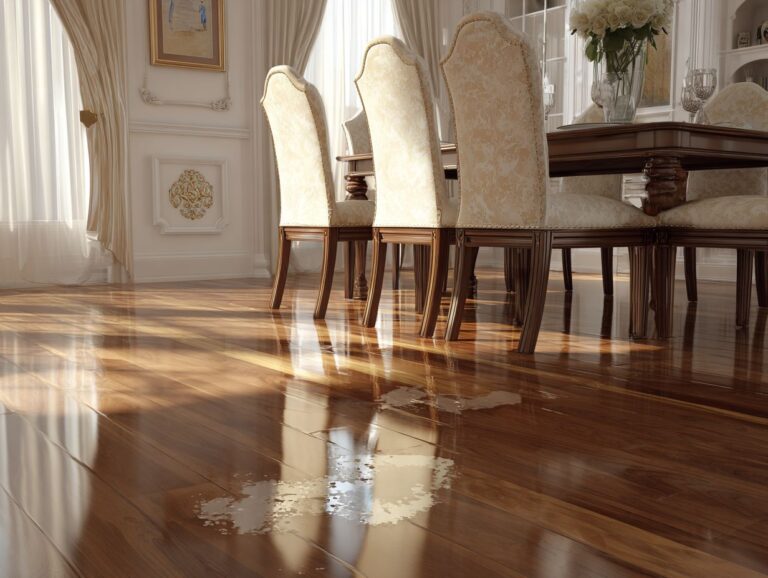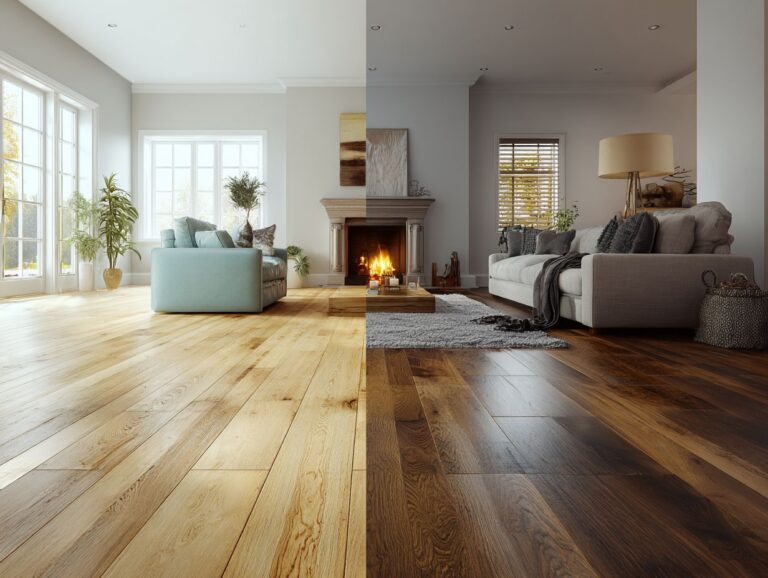Natural Stone Flooring Types – Marble, Granite, Slate Guide
Contents
- Introduction to Natural Stone Flooring
- Natural Stone Flooring Market Insights
- Types of Natural Stone Flooring
- Marble Flooring
- Granite Flooring
- Slate Flooring
- Comparative Analysis of Marble, Granite, and Slate
- Frequently Asked Questions
- What are the benefits of using natural stone flooring types like marble, granite, and slate?
- What is the difference between marble, granite, and slate?
- Can natural stone flooring be used in high-moisture areas?
- How do I maintain and care for my natural stone flooring?
- Can I install natural stone flooring myself?
- What factors should I consider when choosing between marble, granite, and slate for my flooring?
Introduction to Natural Stone Flooring
Give your space a classic and lasting look with natural stone flooring. From the luxurious appeal of marble tiles to the rugged durability of granite flooring and the unique charm of travertine stone, each type offers distinct advantages. This guide will look at different kinds of natural stone, their advantages, and how to select the best one for your home. Learn how these beautiful materials can improve your interior design and offer long-lasting attractiveness.
Key Takeaways:
What is Natural Stone Flooring?
Natural stone flooring is made from materials like marble, granite, and slate. It provides a distinct look and is an environmentally friendly choice for both indoor and outdoor spaces.
Each type of stone possesses distinct attributes. Granite lasts a long time and doesn’t scratch easily, so it’s great for places with a lot of activity.
Marble has a stylish and rich appearance, but it can get stained quickly and requires frequent sealing. Slate provides an earthy texture and natural slip resistance, ideal for outdoor patios.
When choosing stone flooring, consider your space’s use and maintenance requirements, ensuring you select a stone that complements both your style and practical needs.
Benefits of Natural Stone Flooring
Natural stone flooring offers many benefits, such as long-lasting strength, simple upkeep, and a classic look that improves any room.
One of the standout advantages is its durability, often lasting over 50 years when properly maintained. For instance, marble tiles can withstand heavy foot traffic while retaining their beauty.
Natural stone is eco-friendly, sourced from quarries that prioritize sustainable practices. Unique appearance is another benefit; no two pieces are identical, adding character to your home.
Natural stone can be costly, making it a wise option to invest in. Properties with slate or travertine floors usually increase in resale value, drawing more attention from buyers. Related insight: Vinyl flooring patterns offer alternatives with a stone look for those considering different styles and materials.
Natural Stone Flooring Market Insights
Natural Stone Flooring Market Insights
When considering new flooring options, one might ponder the differences between porcelain and ceramic tiles. To make an informed decision, it’s crucial to understand the composition, cost, and durability of each type. For further insights, our comprehensive guide on Porcelain vs Ceramic Tile offers detailed comparisons and valuable information.
Market Statistics and Forecast: Market Growth and Sales
Market Statistics and Forecast: Industry Demographics
The Natural Stone Flooring Market Insights give a full summary of how the industry has grown and the details about the people involved, highlighting trends in sales, money spent on building, and employment in the dimension stone sector in the U.S. This information demonstrates the strong position of the natural stone market and its potential to grow further.
Market Statistics and Forecast reveal a 4.8% increase in stone flooring sales in 2017, indicating a healthy demand for natural stone products. This growth can be attributed to the aesthetic appeal and durability of natural stone, which are increasingly valued in both residential and commercial construction projects. In 2018, the 4.0% increase in construction spending This highlights the strong investment in infrastructure and construction, increasing the need for quality flooring materials such as natural stone.
Looking forward, the market exhibits optimism, with 82.0% of companies expecting a sales increase in 2019. This confidence shows the ongoing economic situation and the lasting popularity of natural stone used in building projects, including floors, countertops, and more.
- Industry Demographics: The U.S. dimension stone industry comprises 9,689 firms, employing 85,966 workers. This workforce size indicates a substantial sector with significant economic contributions, evident in the $3.153 billion payroll. These numbers indicate that the industry offers a lasting product and creates many jobs, helping local economies throughout the country.
The Natural Stone Flooring Market Insights showcase a lively industry set for expansion, fueled by rising sales, construction spending, and a big, engaged workforce. As the demand for durable and aesthetically pleasing building materials continues, the natural stone market is well-positioned to capitalize on these trends and expand its footprint further.
Types of Natural Stone Flooring
Different kinds of natural stone flooring meet various styles and practical uses, each with distinct features and uses. For those considering alternatives, vinyl flooring offers versatile patterns including stone and wood looks (explore more in our Vinyl Flooring Pattern Options guide).
Overview of Various Types
Natural stone flooring comes in different types: marble, granite, slate, limestone, and quartzite. Each has its own features and best uses.
-
Marble, known for its elegance and subtle veining, is ideal for luxurious interiors like living rooms and bathrooms but can be prone to staining.
-
Granite, known for its strength and range of colors, is ideal for busy areas like kitchens.
-
Slate has a natural look and is not slippery, which makes it a good choice for outdoor patios.
-
Limestone, softer and more porous, is best used in low-traffic areas or as a decorative element.
-
Quartzite looks like marble but is as tough as granite, making it a good choice for both indoor and outdoor use.
Marble Flooring
Marble flooring is known for its shiny look and long history in building and design, giving a rich feel to spaces.
Characteristics of Marble
Marble is popular for its smooth look, one-of-a-kind patterns, and shiny finish, making it a favorite for high-end flooring.
This high-quality stone is available in different kinds, such as Carrara, which is mostly white or blue-grey. It is valued for its gentle beauty and its important role in art and building history.
Crema Marfil features warm beige tones, perfect for a cozy, inviting space.
For durability, consider Apache Gold, often used in high-traffic areas due to its resistance to wear.
Different kinds of marble require specific maintenance. For example, grey marble must be sealed to avoid stains.
Choosing the right one depends on aesthetic preferences and practical applications.
Popular Marble Colors and Patterns
Popular marble colors are white, beige, and black. These colors bring impressive looks to decorations in modern designs.
White marble, such as Carrara, is frequently used in kitchens for countertops due to its timeless elegance and ability to brighten spaces.
Beige tones, like Crema Marfil, often find their place in bathrooms, creating a warm, inviting atmosphere.
Black marble, such as Nero Marquina, adds a touch of sophistication to dining areas or accent walls.
Each color introduces a unique aesthetic, so consider the overall design theme when selecting marble for your projects.
For visuals, check out sites like Houzz or Pinterest to get ideas for your selections.
Installation Process for Marble
Installing marble flooring requires careful planning and execution, typically involving a professional installer due to its weight and fragility.
Begin by preparing the subfloor, ensuring it is clean, dry, and level-this can take a day or two.
Next, apply a thin-set adhesive using a notched trowel, ensuring even coverage for the marble tiles.
After laying the tiles, allow the adhesive to cure before grouting, which usually takes another couple of days.
The total installation cost ranges from $10 to $30 per square foot, with professional installation often extending the timeframe to about a week.
Proper moisture protection is also essential to prevent damage.
Maintenance and Care for Marble
Marble flooring requires specific maintenance practices to preserve its polished finish and prevent damage from stains and scratches.
To maintain marble flooring, start by using a pH-neutral cleaner to avoid etching the surface. Clean spills immediately to prevent stains, especially from acidic substances like citrus juice or vinegar.
Every 6-12 months, use a sealant on the marble to improve its protection.
For minor scratches, consider using a marble polishing powder, which can effectively restore the shine. Avoid abrasive tools, as they can damage the surface. Regularly sweeping or vacuuming also helps minimize debris buildup.
Granite Flooring
Granite flooring is a durable option for high-traffic areas, known for its strength and unique appeal.
Characteristics of Granite
Granite is characterized by its weather resistance, unique patterns, and ability to withstand heavy use without compromising its beauty.
This igneous rock primarily consists of quartz, feldspar, and mica, giving it its distinctive speckled appearance. It’s tougher than stones such as marble or limestone, which makes it a good choice for kitchen counters and outdoor areas.
Granite displays different colors and patterns, often shaped by where it comes from in the earth. Notable sources include Italy, renowned for its luxurious patterns, and Turkey, which provides affordable yet captivating options.
Picking the right slab means looking closely at its surface and feel to see if it fits your style and practical needs.
Popular Granite Colors and Patterns
Popular granite colors include gray, black, and beige, featuring beautiful patterns that add depth and richness to any space.
Gray granite, like ‘Silver Pearl’, works well for contemporary kitchens, while ‘Black Galaxy’ is perfect for sleek, modern designs.
Beige options, such as ‘Giallo Cream’, are excellent for warm, inviting spaces, particularly in traditional homes.
For ideas on using these colors, look at different examples on Houzz or Pinterest to see how they improve countertops, backsplashes, and floors.
When choosing granite, consider the overall aesthetic of your room and how the color complements your existing decor.
Installation Process for Granite
Putting in granite flooring needs exact measurements and experienced workers to get a flat surface.
Begin by preparing your substrate; it should be clean, dry, and level. Use a cement-based mortar for added stability.
- Next, measure and cut your granite tiles, ideally with a wet saw for accuracy. Leave a space between tiles for grout; use spacers to make sure the gaps are even.
- Once the tiles are laid, allow them to set for 24 hours before sealing the joints with a silicone-based sealant.
Typically, granite installation can take 2-3 days, with costs ranging from $5 to $10 per square foot, depending on the complexity and finish.
Maintenance and Care for Granite
Granite flooring is relatively low-maintenance but requires regular sealing to maintain its luster and prevent staining.
To maintain your granite floors, apply a sealant every 6-12 months, depending on foot traffic.
Use a pH-balanced cleaner specifically designed for stone to prevent damage – products like Granite Gold or StoneTech work well.
In areas with a lot of foot traffic, apply a slip-resistant coating yearly to improve safety.
Check often for small chips or cracks and fix them quickly using a granite repair kit.
This proactive maintenance will extend the life of your flooring and preserve its stunning appearance.
Slate Flooring
Slate flooring offers a tough, natural appearance and can handle severe weather, making it excellent for indoor and outdoor use.
Characteristics of Slate
Slate is known for its natural attractiveness, distinct textures, and ability to prevent slipping, which makes it a favorite choice for busy areas and outdoor settings.
This metamorphic rock is primarily composed of clay minerals, which give it a fine-grained texture and a range of colors, including gray, green, and black.
Slate is a great option for patios, walkways, and roofing because it is less likely to chip compared to stones like granite or marble. It is durable and withstands various weather conditions, retaining its color, which makes it suitable for outdoor use.
When deciding to use slate for a project, check if its non-slip features will improve safety, particularly in wet areas.
Popular Slate Colors and Patterns
Common slate colors include gray, green, and purple, known for their earthy tones and beautiful layered patterns.
These shades serve different design purposes across various applications.
For instance, gray slate is favored for contemporary spaces, providing a sleek, modern look, while green slate adds a touch of nature, perfect for outdoor areas.
Purple slate stands out in interior design and gardening. For ideas, look at websites such as Pinterest or Houzz. You will find plenty of photos showing these colors used in different ways, from floors to roof tiles.
Installation Process for Slate
Putting in slate flooring involves careful handling and exact cutting to keep its natural edges and look.
Begin by preparing the subfloor; it should be clean, level, and dry. Next, measure and cut the slate tiles using a wet saw for accuracy. Make sure each piece fits tightly together, leaving a 1/8-inch gap for grout.
After laying the tiles, let them set for 24 hours before grouting. Use a sanded grout for gaps larger than 1/8 inch.
Installation typically costs between $5 to $15 per square foot, with an average completion time of 2-3 days for a standard room.
Maintenance and Care for Slate
Maintaining slate flooring involves regular cleaning and periodic sealing to preserve its beauty and longevity.
To clean slate, use a pH-balanced stone cleaner mixed with warm water. Avoid acidic cleaners that can damage the surface.
To remove stubborn stains, combine baking soda with water to create a paste. Put the paste on the stain and leave it for 10-15 minutes, then scrub softly.
Put a breathable sealant on slate every 1 to 3 years. This will help guard against water and marks.
Check your floors often to spot any signs of damage. Fixing scratches or chips quickly helps keep them looking good and lasting longer.
Comparative Analysis of Marble, Granite, and Slate
Looking at marble, granite, and slate shows clear pros and cons related to how long they last, how much they cost, and how they look.
Durability and Longevity
When considering durability, granite stands out for high-traffic areas, while marble and slate offer distinct longevity properties suitable for different applications.
Granite’s resilience makes it ideal for countertops and flooring in busy kitchens. It resists scratches and stains, so it stays in good condition even with regular use.
In contrast, marble is better suited for low-traffic spaces such as bathrooms or decorative accents, where its timeless beauty can shine without the wear from high foot traffic.
Slate, known for its natural slip resistance, performs well in outdoor settings like patios and walkways, often lasting decades if properly maintained. If you’re interested in alternative materials for flooring, such as vinyl options, you might find our comparison of sheet vinyl, vinyl plank, and vinyl tile insightful.
Knowing these features helps you pick the right stone for your needs.
Cost Comparison
Cost comparison shows that while marble can be a premium option, granite and slate offer varying affordability depending on quality and sourcing.
Marble typically ranges from $60 to $120 per square foot, including installation, due to its luxurious appearance and higher maintenance needs. In contrast, granite costs about $40 to $100 per square foot, combining durability with a lower upkeep. Slate remains the most budget-friendly at $20 to $50 per square foot, offering a unique aesthetic.
For a standard kitchen countertop installation, expect to spend about:
- $2,000 to $5,000 for marble
- $1,500 to $4,000 for granite
- $1,000 to $2,500 for slate
demonstrating significant cost differences based on your stone choice.
Aesthetic Appeal
Aesthetic appeal varies significantly among marble, granite, and slate, impacting the overall look and feel of a space.
Marble has a classy and sophisticated look, making it perfect for luxurious homes and businesses. Its unique veining patterns contribute to a timeless feel, perfect for spaces like entryways or bathrooms.
In contrast, granite’s strength and range of colors make it a flexible option for kitchen countertops, where both appearance and use are important. Slate, with its earthy tones and textured surface, works well in rustic designs and outdoor areas.
Each stone type improves particular styles and sets a distinct atmosphere suited to the intended space.
Frequently Asked Questions
What are the benefits of using natural stone flooring types like marble, granite, and slate?
Natural stone flooring is known for its durability, strength, and timeless beauty. These types of flooring are durable enough to handle a lot of use and can last for many years, making them an affordable option for homeowners. Also, natural stone flooring is easy to care for and can increase the worth of your home.
What is the difference between marble, granite, and slate?
Marble is a metamorphic rock that is formed from limestone. It is recognized for its stylish and high-end appearance, featuring distinctive lines. Granite, on the other hand, is an igneous rock that is formed from molten magma. It is more durable than marble and comes in a variety of colors and patterns. Slate is a strong, fine-textured rock that works well for many indoor and outdoor uses.
Can natural stone flooring be used in high-moisture areas?
Yes, natural stone flooring is a great option for high-moisture areas such as bathrooms and kitchens. However, make sure to properly seal the stone to stop water damage and stains. It is recommended to choose a textured or honed finish for better slip resistance.
How do I maintain and care for my natural stone flooring?
Regular sweeping and occasional mopping with a mild cleaner are usually enough to keep your natural stone flooring clean. Instead, avoid using strong chemicals and acidic cleaners that could harm the surface of the stone. It’s a good idea to reseal the stone every few years to keep it shiny and safe from stains.
Can I install natural stone flooring myself?
While it is possible to install natural stone flooring yourself, it is not recommended unless you have experience and knowledge in flooring installation. Natural stone is heavy and can be challenging to handle, and incorrect installation can cause many issues later on. It is best to hire a professional for a perfect and long-lasting installation.
What factors should I consider when choosing between marble, granite, and slate for my flooring?
When choosing between these natural stone flooring types, consider factors such as your budget, the desired look and style, the level of maintenance you are willing to do, and the location of the room. Marble and granite are more expensive but offer a luxurious look, while slate is more affordable and has a more rustic appearance. Think about how long-lasting and useful each type will be for the room where you want to put it. For those weighing the benefits of stone versus other materials, exploring the differences between WPC and SPC vinyl flooring might offer valuable insights into durability and cost-effectiveness.
